The Last War of Prince Michael Shein
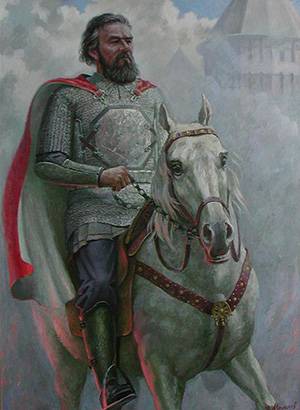
The 1 signed on December 1618 of the year in the Trinity-Sergiev monastery in the village of Deuline between Russia and the Polish-Lithuanian Commonwealth signed an armistice for 14 years and 6 months. This peculiar feature was summed up under the events of a long, incredibly heavy, sometimes even hopeless Time of Troubles and which became its integral part of the Russian-Polish war. The terms of the truce cannot be called easy and painless for the Russian side. The affiliation to the Polish crown of cities already captured by the Poles was confirmed: among them Smolensk, Novgorod-Seversky, Roslavl and others.
In addition, part of the territory that was formally controlled by Russian troops passed under the control of the Polish-Lithuanian Commonwealth. The Polish crown should have been transferred to Toropets, Starodub, Krasny, Chernigov and a number of other settlements, together with their districts and counties. It was specifically stipulated that all the fortresses should be given along with the guns and ammunition to them. The entire population, primarily peasants and commoners, remained in places of permanent residence. The unrestricted relocation was permitted only to nobles with servicemen, merchants, and clergy. The young Tsar Michael, the first of the Romanov dynasty, officially refused the titles of Prince of Smolensk, Livonian and Chernigov. Now their carrier was the Polish king. The Poles pledged to return the members of the Embassy of Filaret, who were actually held hostage, Sigismund III Vaza refused the title of Tsar of Russia.
There is still no consensus on the need for the Russian side to sign such a disadvantageous agreement. Despite the presence of the Polish army in the depths of Russia, in the vicinity of Moscow, the foreign policy position of the Commonwealth in other areas was far from favorable. Contradictions with Sweden were growing, young Sultan Osman II, who ascended the Istanbul throne, like many of his predecessors, wanted to begin his rule with new victories and began to prepare for a big campaign in Poland. The military invasion of the Turks took place in 1621, but was stopped by King Vladislav in the Battle of Hotin. In the north in the same year 1621 landed the Swedish king Gustav II Adolf with a large army, which was the beginning of a grueling eight-year Swedish-Polish war. However, when political conditions seemed favorable for the continuation of the war, by the beginning of 1618, Russia was in the extreme stage of ruin and devastation. Destroyed and depopulated cities, weak central power for the time being, an abundance of all sorts of gangs and freelance robbery groups, huge losses among the population — all this lay on another side of the balance when negotiating with the Poles. And this bowl outweighed.
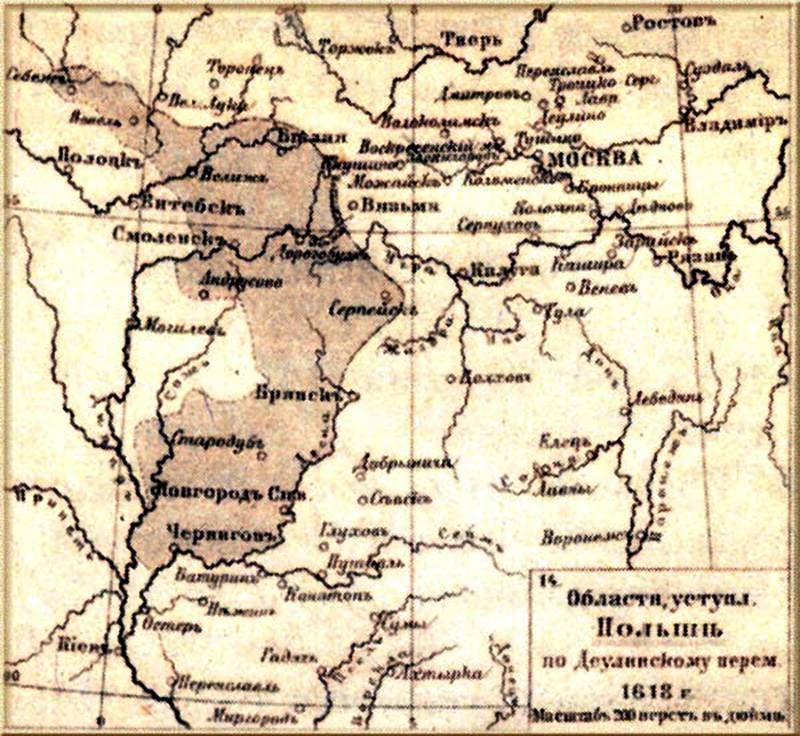
Between the Troubles and the War
Russia has received such a long-awaited respite to somehow put in order almost all aspects of government. It was difficult to overestimate all the destructive consequences of the Troubles. The fragile truce with the Commonwealth did not bring calm on the western frontiers. Despite the fact that attempts to throw the dice in a big way in a game called “False Dmitry” have already been made three times and each time less and less successfully, some brave souls were still there. From time to time the Russian frontier shuddered at the next rumors and "reliable news" about the next "miraculously saved prince", but the matter did not reach any large-scale actions. Periodically, the borders were violated by private armies or gangs of Polish magnates, who did not care about all the subtleties of a diplomatic nature.
At the interstate level, tensions were maintained by the fact that Sigismund III’s son still continued to bear the title of Grand Duke of Moscow and was not in a hurry to refuse him. The desire for compromise and "political détente" is clearly not listed in the arsenal of Polish diplomacy. Moreover, the aristocracy of Rzecz Pospolita expressed overt skepticism about the legitimacy of the election and the rights to the throne of the young Tsar Mikhail Fedorovich Romanov. Many high-born gentlemen were confident that, they say, the king was put by the Cossacks, thieves and other mob without coordination with the boyars. However, the conditions under which the Polish kings were elected, the nobleman gently preferred not to recall modestly.
While Russia continued to recover and to solve the pile of problems that had accumulated almost from the reign of Fyodor Ioannovich, the Commonwealth experienced not the most prosperous period of its stories. In 1618, the uprising in Prague marked the beginning of the longest and bloodiest conflict of the 17th century, which went down in history as the Thirty Years War. Europe divided into two irreconcilable camps: at first, Catholicism struggled with Protestantism, and then religious affiliation did not play a special role in the choice of opponents and allies. Polish-Lithuanian Commonwealth was, as it were, away from the storm that broke out in the center of Europe, but in 1621 a conflict with Sweden that had lasted eight years began. Its origins were, on the one hand, in the desire of Sigismund III to unite Poland and Sweden under its rule, and on the other hand, in the stubborn striving of his cousin, Gustav Adolf II, to prevent this. The long war ended with the signing of the Altmark Peace in September 1639, according to which Sigismund III recognized the rights to the Swedish throne for his cousin and transferred him possession of Livonia along with Riga, Memel, Pillau and Elbing. Interestingly, during this conflict, the Swedes persistently tried to involve Russia as an ally in the war, but Moscow rejected this venture completely.
The conditions of the Deulinskiy truce, of course, were recognized as unacceptable and requiring revision, but such a step required proper preparation - at that time agreements between the states were mostly challenged with iron, and only when it was blunted did slow conversations in tents and tents come. Russia was preparing for revenge.
Preparation for revenge
The fact that the truce signed with the Poles was no more than a pause before the next conflict was understood in both capitals. But in Moscow, where they felt hurt, they perceived it more acutely. Relations with the Commonwealth, and so devoid of good-neighborly cordiality, constantly deteriorated. Economic rivalry played a significant role in this. Europe devastated by war was in dire need of bread, and the main suppliers of grain were Russia and the Polish-Lithuanian Commonwealth. Food prices rose several orders of magnitude, and trading was a very profitable occupation. Needless to say, Russian and Polish merchants fiercely competed among themselves in the grain market, and this also did not help stabilize relations between Warsaw and Moscow.
While imperial and Protestant armies marched through the fields of Europe, Russia was preparing its resources for the upcoming battle. First, as theorists and practitioners of military art used to say from different times, three things were needed for the war: money, money, and again money. Patriarch Filaret, being the father of the young tsar and having the official title of co-ruler, often made extraordinary levies from monasteries for military needs. Most of the proceeds from the sale of grain abroad were also spent on the reorganization and arming of the army. In addition to the funds available in England, a loan was taken on 40 in thousands of gold. Of course, the British helped Russia with money and purchases of various materials for military purposes not from a sudden flood of philanthropy. The fact is that the Catholic Rzeczpospolita in Protestant circles was considered a potential ally of the Habsburgs, and therefore a war between the Russian tsar and the Polish king would be a profitable venture for them. Through Hamburg and Dutch merchants, military equipment was procured - every year the cost of this item increased. In 1630 – 1632 A large amount of lead and iron was delivered to Arkhangelsk from Holland, Sweden and England. Despite the ban on the export of metals from Foggy Albion, an exception was made for Russia. The entry of the Polish-Lithuanian Commonwealth into the Thirty Years' War was perceived by the lords as far more evil than the concession of valuable raw materials to the Russians. Purchased and weapon - In 1629, in the Netherlands, an order was placed for the production of 10 thousand muskets.
A lot of attention was paid not only to material and technical support, but also to personnel issues. After all, the experience of the battles of the Time of Troubles showed that the archers and noble cavalry are not sufficiently prepared for the modern conditions of war and are often inferior in organization to the Poles. To solve this problem, the movement was carried out in two directions. First, the Russian army, it was decided to strengthen the mercenaries. Secondly, before the war itself, the formation of the “regiments of the new system” began from its own human resources.
In order to hire foreign “soldiers of fortune” in January, 1631 was sent to Sweden by a colonel, a Scot in the Russian service, Alexander Leslie. He was an experienced man in military affairs, who had in his military career served the Polish and Swedish crowns. In 1630, he arrived in Moscow as part of the Swedish military mission, was accepted by the king and subsequently expressed a desire to switch to Russian service. Heading towards his former employers, Leslie was instructed to recruit five thousand infantry and contribute to hiring craftsmen for the Russian service who were successful in the ability to make tools. The Swedish king Gustav Adolf reacted with understanding to the Scottish mission, however, in preparing for active participation in the Thirty Years War, he refused to provide the soldiers. Leslie had to make an effort and select the appropriate contingent in other countries: they managed to recruit mercenaries in Holland, England and Germany. In total, four regiments were ready for shipment to Russia. In one, the British and Scots prevailed, in the rest the Germans and the Dutch. However, due to desertion and disease, no more than four thousand people reached Moscow.
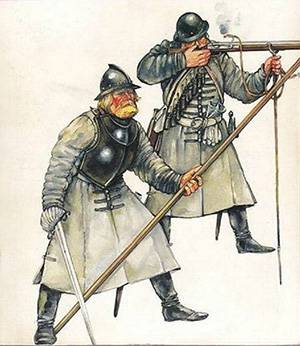
The soldiers of the regiments of the new system
The regiments of the “new order” began to form shortly before the war. At the beginning of 1630, letters were sent to major cities about the recruitment of “unmarked” boyar children to serve in Moscow to study with foreign specialists in the amount of two thousand people, of whom it was then planned to form two regiments. Recorded was promised a salary of five rubles a year and the so-called fodder money. Gunpowder, food and lead were issued at public expense. However, despite the call, the number of boyar children who wanted to go to the new regiments, at first did not exceed hundreds of people. Then it was decided to expand the recruiting contingent, allowing representatives of different classes to sign up as soldiers.
By these measures, by December 1631 was able to recruit more than three thousand people without great difficulty. In total, by August 1632, four regiments were formed, divided into companies. The officers there were mostly foreigners, and the personnel were Russian. The successful experience of creating infantry regiments was used in cavalry. In the summer of 1632, the formation of the Reitars regiment began. Its equipment took place at a more satisfactory rate, mainly due to the fact that the nobility considered service in the cavalry a much more prestigious occupation than to pull an infantry strap. By December, the 1632 regiment had been brought to near full strength. Its composition was expanded - it was decided to create an additional dragoon company, and bring the number of regiments to 2400 people. In total, this unit was composed of 14 mouth. Already during the hostilities, another cavalry regiment was formed, this time a dragoon regiment.
Revenge
In April, 1632, the king of the Commonwealth, Sigismund III, died - an interregnum began in the country, accompanied by a disorder of the gentry. In order to observe the procedure of electing the new king, which is traditional for Poland, it was necessary to assemble an election Saeima. It was generally a very convenient time for the start of hostilities, for which we had already been preparing for a long time. Europe was blazing hot with the flame of the Thirty Years War, and its participants were consumed by clarifying the relationship with each other. Formally, an ally of Russia could be Protestant Sweden, but its king, Gustav Adolf II, preferred to act in Germany, where he found his death on the battlefield of Lutzen in November 1632.
Already in spring the Russian army began concentrating on the western frontiers. 20 June Zemsky Sobor proclaimed war of the Commonwealth. In the same month, troops headed by voivods, princes Dmitry Cherkassky and Boris Lykov, began to move towards Smolensk. A very good situation was created to strike at the Poles, but personal circumstances intervened in the events. Lykov and Cherkassky were in charge and began to find out which of them is more notable and, therefore, the main one. While the commanders were engaged in such an important, but not the most appropriate, action, the troops were forced to stop. The commanders could not find out which of them was more "cool", and a special commission headed by Prince Khilkov was sent to the army from Moscow. Arriving at the main apartment, the emissaries of the capital were drawn into princely litigation, which dragged on for nearly two months. Finally, in order to put an end to this empty and harmful drawback, Tsar Mikhail, at the suggestion of Patriarch Philaret, replaced the rowdy governor with boyar Mikhail Shein, who was the head of Smolensk defense in 1609 – 1611.
The steppe factor has also been added to the conflict in the highest military circles. Taking advantage of the weakening of the Russian troops in the south, the Tatar army of Khan Janibek-Girey advanced from the Crimea and struck at the Kursk and Belgorod lands. Only by August the Crimeans managed to push back to the steppe. The crisis on the southern frontiers definitely hindered the development of military operations against Poland. The summer months favorable for the offensive were missed.
At the time of the arrival of the new commander in the army, there were more than 25 thousand people (of whom almost four thousand were foreign mercenaries), 151 cannon and seven mortars. According to the plan of the war, Shein was ordered to seize Dorogobuzh, if the city could not be taken on the move, then it was necessary to leave part of the army at its walls, and with the main forces to go to Smolensk, which was the main goal of the war. From the lingering squabbles among the leadership, as a result of which Prince Cherkassky still proved his name, but was still replaced by Shein, active hostilities began only in late August.
Despite the two-month delay, at first the military happiness was favorable to the Russian army - the Poles were in such a difficult situation that they could not immediately organize effective resistance. October 12 was taken the city of Serpeysk. October 18 voivod Fedor Sukhotin and Colonel Leslie captured Dorogobuzh. Subsequently, Dorogobuzh was used as a supply center for the Russian army — extensive warehouses with various reserves were set up in it. White Fortress surrendered to Prince Prozorovsky, Polotsk suffered great damage, where it was not possible to take the citadel with the Polish garrison, but the posad was burned. A number of cities were taken, among them Novgorod-Seversky, Roslavl, Nevel, Starodub and others. Not satisfied with the success, Shein spoke with the main forces at Smolensk.
5 December 1632, the Russian army began the siege of Smolensk. The city was surrounded by siege fortifications, and the artillery began systematic shelling. Unfortunately, Shein soon had to face supply problems — gunpowder for the guns was being driven at an extremely slow pace, which directly affected the effectiveness of the bombardment. The Poles were able to quickly eliminate the destruction in the walls, as an additional measure to improve the defenses outside the walls of the fortress walls was erected. 26 May 1633, it turned out to blow up a section of the wall, but the attack undertaken on the breach was repulsed. 10 June was stormed, which also ended in failure. The lack of gunpowder in the Russian army became permanent.
While the siege of Smolensk continued, the Polish gentry was completely absorbed in the election of the king. This procedure seemed to them much more important than the enemy army that had invaded the country. While there were tense political disputes, accompanied by intrigues and bribes, no active actions were taken to unblock the besieged city. But the Poles did not disdain to lay out a hefty amount of gold to the Crimean Khan for organizing a raid on Russian territory. Forming the army, the Russians had to greatly reduce the number of garrisons on the southern border, which the Crimeans took advantage of.
In the early summer of 1633, the son of Khan Mubarek-Giray led a campaign of the 30-thousandth army against Russia. Tatars managed to devastate the environs of Serpukhov, Tula and Ryazan, to take big booty and prisoners. Having learned about the raid, many nobles, whose estates were in the regions subjected to devastation, simply deserted from the army under the specious pretext of saving property. While the khanate on Polish gold was organized by the robber "second front", its sponsors finally gathered their thoughts and, as expected, elected the son of Sigismund III, Vladislav, who received the crown under the name of Vladislav IV, as king.
Under the walls of Smolensk
While Shein, overcoming logistical and organizational difficulties, stormed Smolensk, the new king quickly assembled an almost 25-thousandth army and at the end of August approached the city besieged by the Russians. He camped on the Borovaya River, almost in 10 km from Smolensk. Vladislav abandoned the waiting tactics and decided to immediately throw the enemy away from the city. The initial strike was planned to inflict on the positions of the Russian army on Pokrovskaya mountain. By this time, Shein's troops, who suffered more losses from desertion than from the impact of the enemy, totaled no more than 20 thousand people. The position of the Polish garrison of Smolensk was extremely difficult - the residents refused to assist the Poles, and they could only rely on their own forces. The commander, Prince Sokolinsky, still had provisions, but there was no forage for horses, and the bad situation was with bad water in the wells.
Against the appropriate army of Vladislav, it was decided to act according to the method of Prince Skopin-Shuisky: to hide from the powerful Polish cavalry behind field fortifications and exhaust the enemy with stubborn defense followed by a counterattack. The first battle with the royal troops occurred 28 August 1633 g. The battle was exhausting - the soldiers of the colonel in the Russian service of Yuri Mattison among the few 1200 people successfully repulsed many of the Poles in numbers. The most significant success of King Vladislav on this day was the successful delivery of a convoy with food to besieged Smolensk. On September 3, considerable reinforcements in the person of the registered and Zaporizhzhya Cossacks approached the king, then artillery and crews arrived at the Polish camp, as well as a significant amount of gunpowder. Now the army of the Commonwealth, even without taking into account the garrison of Smolensk, had an advantage over the enemy.
Shein's position was aggravated by the active flight of European mercenaries to Vladislav. On the morning of September 11, a large number of Poles attacked the fortifications on Pokrovskaya Mountain and the nearby camp of the governor Prozorovsky, seeking not only to knock out the Russians, but also to cut them off from the main camp of Shein. After a two-day bloody battle, Colonel Mattison retreated with the remnants of his unit to the main forces. And the departure was secretly from the enemy. On September 13, the blow was already delivered to Prozorovsky’s positions, with the royal troops actively using artillery. Learned by experience, the Poles were in no hurry to attack the well-established Russians, exhausting them with intense fire. The following days were filled with intense positional battles, where the king’s soldiers sought to dislodge Prozorovsky from his fortifications with artillery duels, attacks and counterattacks.
Vladislav managed to restore a permanent communication with Smolensk, the garrison of which now regularly received supplies and reinforcements. After a week of almost continuous battles, the Prozorovsky September 19 retreated with his men to Shein’s main camp. The loss of the Pokrovskaya mountain was dangerous because the connection with the main camp was broken. In the abandoned fortifications, some of which were prudently set on fire, the Poles got siege weapons and some of the reserves. Other siege camps near the walls of Smolensk were abandoned. Prozorovsky made this maneuver quite skillfully and, most importantly, covertly — despite the abundance of cavalry among the Poles, they could not prevent the Russians from withdrawing from under the walls of the city. Approval of Shein’s actions was expressed by the tsar himself: well, “that we have become together with all our people!”
There was another reason why the Russian commander had to concentrate all his forces in one place: the unreliability of foreign mercenaries, who rather actively began to move to the enemy. In fact, the siege of Smolensk ceased, and both armies concentrated in their camps against each other. Given the numerical superiority of the enemy and the desertion of foreigners to Shein, it would be logical to retreat along the Moscow road in order to preserve and subsequently put in order the army. However, in Moscow they judged differently: Tsar Mikhail forbade in his letter to retreat from Smolensk, promising to send soon assistance in the person of the newly formed army under the command of the princes of Cherkassy and Pozharsky. In addition, in the conditions of the beginning of the autumn thaw, serious difficulties would have arisen in transporting heavy siege artillery on muddy roads.
Since the Poles admitted that it was impossible to take the strongly fortified camp of Shein by direct assault, henceforth the efforts of the royal army were aimed at slow strangulation by interrupting communications with the “mainland”. In early October, the Polish detachment took and burned Dorogobuzh, with all of its enormous reserves for the Russian army. October 7 by order of the king was occupied Zhavoronkova mountain, which dominated the Russian camp. It was impossible to leave without consequences, and Shein attacked Polish positions on October 9. The bloody battle lasted a whole day and subsided with the onset of darkness. Both sides suffered heavy losses, but the king managed to keep Zhavoronkov Mountain behind him. Having placed cannons on it, the Poles began to regularly bombard the Russian camp.
Decoupling
The position of Shein's troops was steadily deteriorating - the Poles took measures to ensure its tight blockade. Soon the supply of supplies ceased. The enemy was also able to periodically intercept messengers who delivered reports to Shein and from him to Moscow. Relations between foreigners became increasingly strained. So, on suspicion of treason and the transfer of important information to the Poles, Colonel Leslie shot another colonel, an Englishman by nationality, Sanderson. In November, problems began with provisions, fodder and money. In order to pay salaries to mercenaries, Sheinu had to borrow from colonels. In December, illnesses added to the famine.
Nevertheless, clashes between the two warring parties took place regularly. Aware of the deteriorating situation of his opponent, Vladislav sent parliamentarians in mid-December with a proposal to conclude a truce. It was proposed to exchange prisoners, and each of the armies had to retreat deep into its territory. Having no authority to sign a truce without instructions from Moscow, from which there was no news because of the blockade, Shein, after long debates with his officers, left the Polish proposal unanswered. The unblocking army of Prince Cherkassky, concentrated near Mozhaisk, was not active, while its other governor, Prince Pozharsky, became seriously ill.
Perhaps indifference to the agony of Shein's troops on the part of the eminent Moscow boyars was also caused by personal motives. At the very beginning of October, 1633, Patriarch Filaret died, and Tsar Mikhail, left without a father and chief adviser, was not up to Smolensk affairs. In early February, food supplies in the Russian camp came to an end, there was nowhere to wait for help, foreign mercenaries, who were not very adapted to the difficult conditions, expressed an increasingly fierce protest.
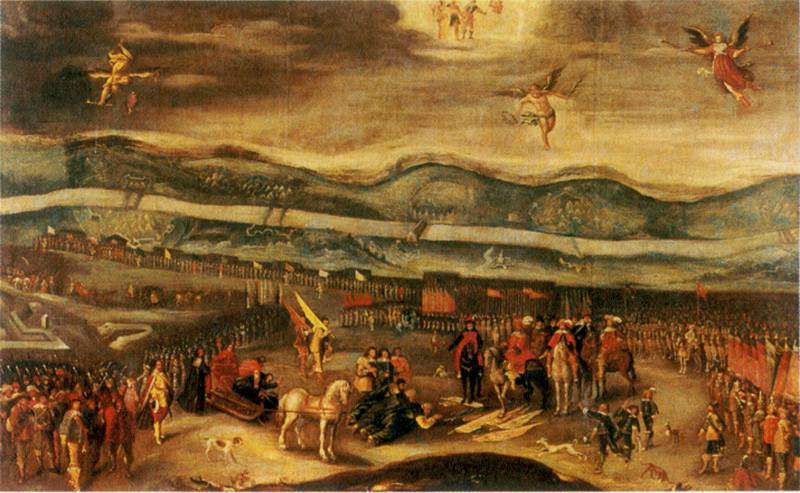
On February 16, after long negotiations on Zhavoronkovaya Hill, a truce was signed between the King and Prince Shein. February 19 Russian troops with folded banners, without drumming began to leave the camp. Disgusted by the long, bloody and exhausting siege, the Poles brought a number of humiliating conditions into the armistice agreement: all banners were folded at the feet of Vladislav, until the coronial hetman named the king allowed them to be raised. Shein and his other commanders had to get off their horses and bow low to the head of the Commonwealth. However, the soldiers went out with personal weapons and firearms, pledging not to participate in the war for four months. In the camp, almost all the artillery was left, and about two thousand sick and wounded, which the Poles should have taken care of. From Smolensk, Shein took home a little more than 8 thousand people - the vast majority of the remaining two thousand foreign mercenaries, without further ado, went to the service of King Vladislav. Fidelity to Russia kept units. Among them was the Scotsman Alexander Leslie.
In Moscow, Shein’s capitulation became known on March 13, 4. A “commission” was immediately set up to investigate the incident, which included many famous boyars. Prince accused of many sins, hanging on him almost all the blame for the defeat. Despite the former merits of Shein during the defense of Smolensk, despite the fact that he managed to keep the army core and withdraw it to Russia, 1634 April 18 Mr. Mikhail Shein and two younger commanders, father and son Izmailov, cut off their heads on Red Square . The verdict, cruel and unjustified, caused unrest in the capital - the prince enjoyed great respect among the people.
Meanwhile, intoxicated with the victory at Smolensk, the Poles rushed to besiege White Fortress, which was defended by a small garrison. The offer of surrender was rejected by the Russians. The commander of the defenders of the fortress said that Shein’s example inspires courage, not fear. Attempts to lay mines under the walls ended unsuccessfully for the Poles. The garrison conducted a skillful raid and heavily patted the besiegers. In the royal army began illness and food shortages.
In addition, Vladislav received very disturbing news. Sultan Murad IV sent a large army to Rzeczpospolita under the command of Abbas Pasha. In such, already becoming desperate, conditions were no longer up to the correct sieges and dashing cavalry raids deep into Russian territory. Messengers with peace offer were sent to Moscow. In Russia, the enemy’s critical situation was not taken advantage of, and on June 3, 1634 between the two states signed the Polyanovsky Peace. His conditions were briefly summarized as follows: an “eternal” world was established, the events of 1604 – 1634. were consigned to oblivion. The Polish king abdicated the rights to the Russian throne and pledged to return the electoral act of the Moscow boyars, sent to him in 1610 year and signed among other father of Mikhail Romanov Philaret. Vladislav refused the title "Prince of Moscow", and Tsar Mikhail Fedorovich removed from his title "Prince of Smolensk and Chernigov," pledging not to sign "the sovereign of all Russia." Russia waived the right to return Livonia, Courland and Estland. Smolensk, Chernigov and a number of other cities were ceded to Poland along with serf artillery and reserves. For the city of Serpeysk, left as part of Russia, 20 thousand rubles were paid out to the Polish-Lithuanian Commonwealth.
The war did not solve a single problem between the two rival states, and the next peace treaty was, in fact, nothing more than an impressive truce. But the diploma on the election of Vladislav, the Poles did not return, because in 1636, it was officially declared “lost”. "Eternal" peace between Russia and the Commonwealth lasted no more than twenty years. The new war, caused by the old contradictions, as well as the adoption of the Zaporozhian Army into Russian citizenship, began in 1654 and lasted for long 13 years. After a long grueling struggle, Russia regained its western bastion - Smolensk and many others lost during the Time of Troubles, the land.
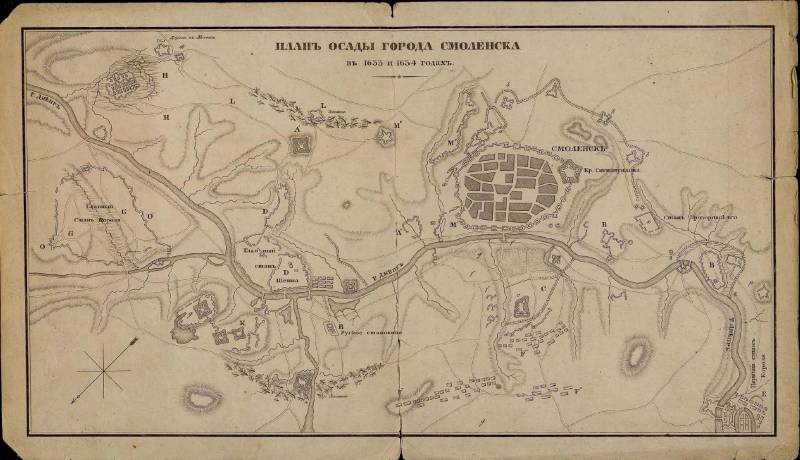
Information